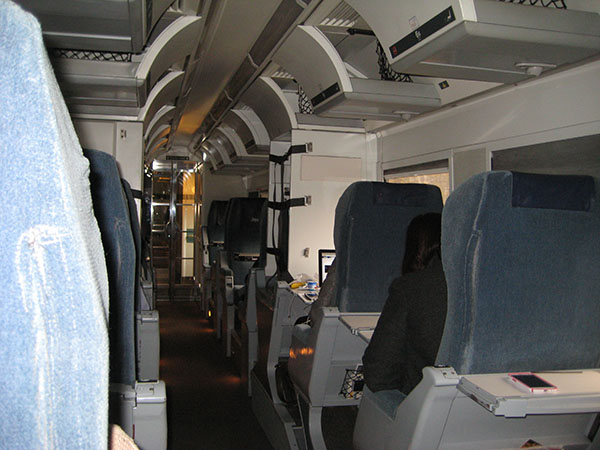It Takes a Lot to Laugh, It Takes a Train to Cry
As far as song titles go, Dylan had a winner with that ^ one. But traveling by train to Quebec City gives it another angle.
Night was falling as we rolled out of Montreal. Only a few distant lights were visible outside. So I took a closer look at the interior of the train.
We were on a newer model, more plush all around, with high seats, arrays of lights, outlets, wi-fi, etc. I love trains. I wish there were more of them. Specifically, I wish I could hop on a train in Potsdam around 8:00 p.m. and wake up as it rolled into New York City around 6:00 the next morning.
This fantasy is always quashed by costs (among other things), but sitting in this passenger car brings the money issue into sharper relief. “Sticker” on this baby has to be more than a million dollars. Probably a lot more. But for the purposes of my dream railway, let’s say I could buy an engine and three cars for a cool $5 mil.
Plying my imagined Potsdam-Penn Station route, I’d have to sell a lot of tickets to pay it off. And then there’s payroll, upkeep, track maintenance and insurance.
It’s expensive. Hardly original or enlightening, I know. But such thoughts are for another time, because we’re rolling into Quebec (or Quebec City, as it’s called in the States) and this little getaway—that began the moment we stepped on the train in Cornwall—is about to take a decidedly different (and far more francophone) turn.
Next: Quebec welcomes the tourist









Would your fantasy train travel the abandoned rail line between Saranac Lake and Lake Placid? Maybe we don’t want to go there!
Seriously though, it’s been a long time since I’ve been inside a VIA train. Your model sure looks lovely. Did you change trains in Montreal?
Yep, we switched trains in Montreal. Our outbound train was on the track next to ours as we rolled in. But we still went upstairs to get some food and see the station.
It reminded me of some of the big ones in Europe: high ceilings, departure boards that really got you dreaming, etc.
We got sushi, en francais! It was a bit mind blowing, but I really like cultural intersections like that.
Jonathan – you make reference to the train station in Montreal with its high ceilings and departure boards. I’ve not seen that station but some of the most spectacular architecture in this country, and around the world for that matter, is train stations. Most of the grand stuff (and it was grand) that still exists is of a past architectural era – magnificent…Grand Central in NYC, Washington’s Union Station, Baltimore’s Penn Station, Union Station in Utica, and the smaller station like Saranac Lake’s Union Depot or the stations in Westport and Lake Placid – I could go on and on. But as we’ve seen an uptick in train travel, especially on the more heavily traveled Amtrak lines, there is even some contemporary architecture that captures the feel of the old stations of an era past. The new station in Rensselaer that serves Albany that opened in 2002 is a great example – beautiful station. I’ll be curious to hear what the station in the old city of Quebec is like.
Mark, I can tell you the Quebec station – Gare du Palais – was designed by the same architect who designed the Chateau Frontenac, the hotel built in the 1890s by the railway. The hotel epitomizes “grand” – it has turrets galore and it towers over the city and the St Lawrence.
From the outside, it’s easy to see the same design elements on both the hotel and train station. From the inside, it’s less obvious. The train station is a little more pragmatic, but still lovely.
But no train station I’ve seen can compare to Grand Central. Just to stand there and look at the ceiling is worth the trip.
The train station in Denver was looking decrepit last I saw it. The walkway to the trains – with plaques next to arched doorways that read “Kansas City” “Chicago” “Los Angeles” “San Francisco” “Seattle” – was torn up. Filled in, rather. All that history is gone. And just imagine taking a train from Denver to San Francisco. The views alone would be worth the ticket price.
We could have trains like those in Canada, or those in Europe, if only our government would re-think their priorities. We currently spend many billions building and maintaining the interstate highway system, in a time when fewer and fewer Americans can afford to drive across the country. Our Federal government spends billions more to underwrite the commercial airline industry though, since 9-11, it has become a royal pain to get through an airport, and the costs continue to soar. This same government, and those on the right in Congress, whine and moan about the costs associated with Amtrack, cutting lines, and reducing services every time they get a chance. If they really want to curtail spending, they would cut off ALL subsidies, and let the market sort it out….Isn’t that what they say they believe?
It’s even worse than that, Michael-
The first two lines from this story in the NYTimes are really depressing:
“Amtrak lost more than $800 million on its food and beverage services over the last 10 years, largely because of waste, employee theft and lack of proper oversight, government auditors have found.
The railroad’s food and beverage service has never broken even since it was required by Congress to do so in 1981.”
Here’s a link to the whole story: http://www.nytimes.com/2012/08/03/us/politics/amtrak-lost-834-million-on-food-in-last-decade-audit-finds.html?ref=us&_r=0
But the railway can make money – maybe – depending on who’s parsing the data. Here’s a piece from Slate.com under the headline, “The Part of Amtrak That People Use Makes Money—The Rest Doesn’t:”
http://www.slate.com/blogs/moneybox/2013/03/01/amtrak_profits_in_the_northeast_where_people_use_it_they_make_money.html